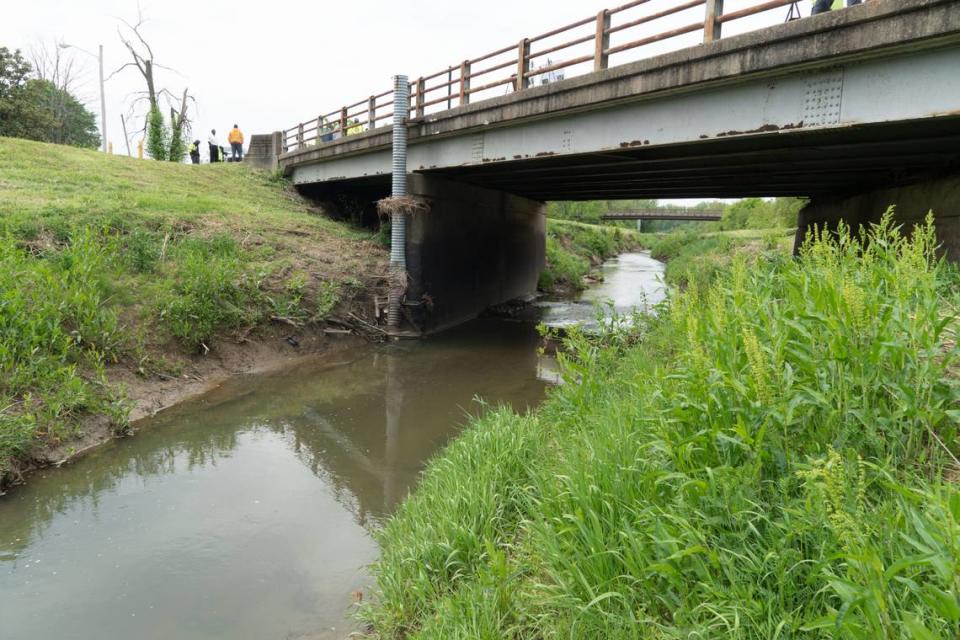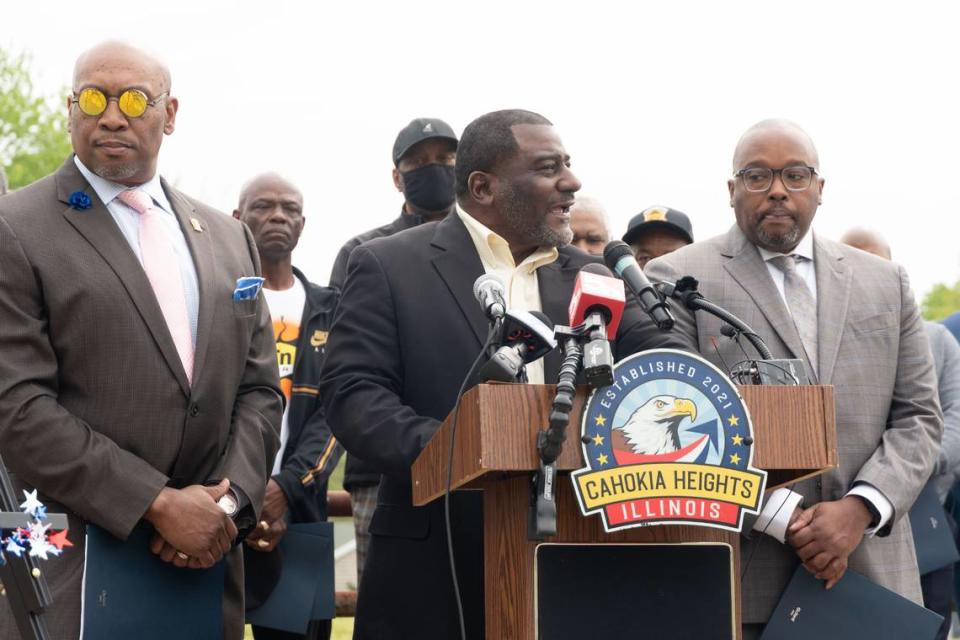Cahokia Heights, East St. Louis can’t stop flooding until this issue is handled, leaders say
Editor’s note: This story was updated Friday, April 28, to include the correct title for Jim Nold at Hurst-Rosche, Inc. and a statement from the U.S. Army Corps of Engineers.
The mayors of Cahokia Heights and East St. Louis are calling on the U.S. Army Corps of Engineers to help them fix a $100 million problem they say is causing chronic flooding in their communities.
Cahokia Heights Mayor Curtis McCall Sr., East St. Louis Mayor Robert Eastern III and representatives from their engineering firms said during a Thursday news conference that they need to address a longstanding capacity issue in the major stormwater drainage canal known as Harding Ditch. And they want help with the large estimated price tag for the work from the federal government.
Last week, the U.S. Army Corps of Engineers presented the cities with recommendations from a floodplain management study that included cleaning small ditches, repairing culverts and upgrading pump stations.
But local officials say flooding would persist despite those efforts because Harding Ditch — the canal those ditches, culverts and pump stations drain into — becomes overwhelmed during heavy rain when it fills with water from neighboring communities.
The 14-mile-long Harding Ditch runs through Collinsville, Caseyville, Hollywood Heights, unincorporated O’Fallon, Fairview Heights, French Village, Washington Park, Belleville, Swansea, East St. Louis and Cahokia Heights.
More rain has been flowing into the canal for years as communities have shifted from farmland, which used to absorb the stormwater, to parking lots and development, officials say. Sediment has also built up over time inside the canal and along its walls, making it more narrow.
“It’s sort of like when your gutters don’t get cleaned out at home and the water runs off your roof. The water can’t go in the gutters so it spills over the top. Except in this case, (water from) your neighbor’s roof is going into your gutter, too,” Jim Nold, a senior project manager for Cahokia Heights’ engineering firm, said during the news conference. Nold works for Hurst-Rosche, Inc.

The agency responsible for Harding Ditch, the Metro East Sanitary District, has been doing minimal maintenance on the canal for decades because that’s what it could afford. Officials said Thursday that lower income communities support the sanitary district, while wealthier communities that benefit from the drainage don’t contribute tax dollars.
Metro East Sanitary District Executive Director Rick Fancher said the budget this year is a little over $3 million, and the district has 28 employees.
The cities whose residents pay the sanitary district include:
East St. Louis
Cahokia Heights
Washington Park
Brooklyn
Fairmont City
Granite City
Pontoon Beach
Madison
Venice
McCall and his son Curtis McCall Jr., an assistant superintendent in Cahokia School District 187, provided copies of their 2021 tax bills to reporters showing they paid the Metro East Sanitary District $26.93 and $55.57, respectively.
McCall Sr. described the situation as environmental and institutional racism because the communities suffering from flooding and shouldering the maintenance costs are predominantly Black.
East St. Louis NAACP vice president George McClellan also spoke at the news conference about the injustice and racism he believes the communities are facing.
“If you were to move those communities or to tell Belleville that 20 of your city blocks would be flooded every three to five years, it would be a problem,” McClellan said. “If you would do the same thing in Fairview Heights to where 20 to 30 of your blocks (are flooded) and people would have to be rescued out of their homes, it would be a problem. If it was a street inside of Scott Air Force Base that was flooded for a day, it would be a problem.
“So why is it fair, why is it equitable in order for you to do it here? It’s not.”
Officials are asking for the U.S. Army Corps of Engineers to help clean the silt out of Harding Ditch and for state lawmakers to redraw the Metro East Sanitary District’s boundaries to include the wealthier communities in its tax base.

Partnering with the U.S. Army Corps of Engineers like Cahokia Heights and East St. Louis are requesting requires a cost-sharing agreement, George Stringham, a spokesman for the St. Louis District, said in a statement.
“The U.S. Army Corps of Engineers, St. Louis District, is committed to providing long-term flood risk management solutions to Metro East communities, to include the cities of Cahokia Heights and East St. Louis,” Stringham stated. “We are looking forward to working with mayors Curtis McCall Sr. and Robert Eastern III, and their teams on this difficult problem within these communities.
“The study referenced can be reopened but it will require a willing and financially capable non-federal cost share sponsor to pursue a comprehensive approach that can lead to recommended actions that reduce this interior flood risk that plague these communities.”
A non-federal sponsor could include entities like the Illinois Department of Natural Resources, the Metro East Sanitary District or the cities, according to Stringham.
For the past several years, Cahokia Heights residents have been drawing local, state and federal attention to the neighborhoods that regularly deal with flash flooding as well as raw sewage backing up in yards and homes. They filed two federal lawsuits over the issues in 2020 and 2021.
Homes on Terrace Drive and Mary Avenue in East St. Louis were destroyed by floodwater last summer when they were submerged for four days after record July rainfall caused severe flash flooding across the St. Louis region.
Emergency personnel have had to rescue people by boat in both Cahokia Heights and East St. Louis neighborhoods when roads become impassable after rain.
Nold, of the engineering firm, estimated the Harding Ditch cleanout project could take at least 14 years to complete, possibly longer.

